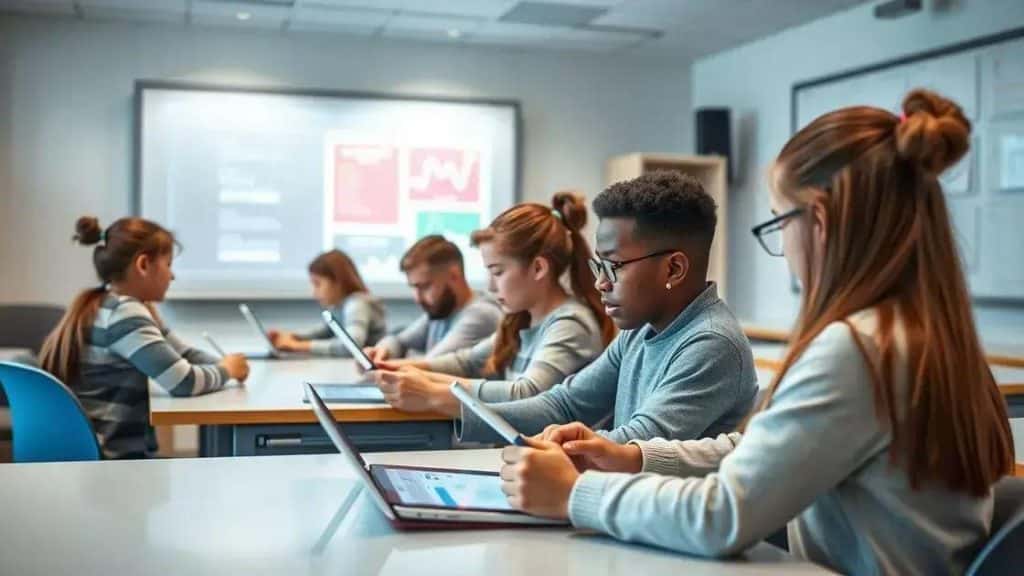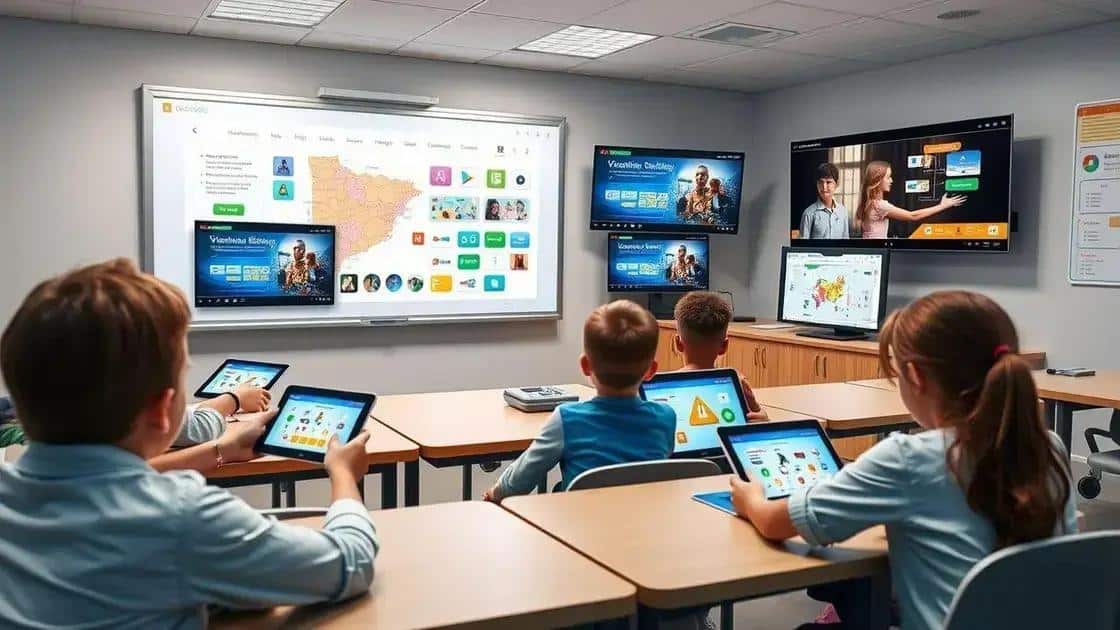Design digital classroom best practices for effective learning

Effective digital classrooms leverage engagement, inclusivity, and technology to enhance student learning, while ongoing assessments ensure that teaching strategies meet the diverse needs of all students.
Design digital classroom best practices are crucial for fostering engaging and productive learning environments. Have you ever considered how the right design can transform student interactions and outcomes? This article delves into effective strategies to enhance your classroom experience.
Understanding digital classroom design
Understanding digital classroom design is essential for creating effective learning spaces that promote engagement and collaboration. In today’s tech-savvy world, good design can greatly enhance the educational experience. A well-designed digital classroom is about more than just technology; it encompasses how we organize space and resources to foster learning.
Key Elements of Digital Classroom Design
Several factors contribute to successful digital classroom design. They include:
- Flexibility: Classrooms should accommodate various teaching styles and activities.
- Technology Integration: Seamlessly incorporating tools like smart boards and tablets enhances learning.
- Student-Centered Spaces: Arranging desks and technology to facilitate collaboration promotes interaction among students.
Additionally, effective digital classrooms use color and lighting to create inviting atmospheres. Natural light is preferable, as it helps to keep students alert and focused. Bright colors can energize the space, while calming colors can help students concentrate.
Creating an Interactive Environment
Another crucial aspect of digital classroom design is interactivity. Digital tools should encourage participation. This can involve:
- Using interactive software that allows real-time student feedback.
- Integrating gamified learning approaches to make lessons enjoyable.
- Facilitating group projects using online collaboration tools.
When students engage actively with the material, they retain information better. Digital classrooms should promote hands-on experiences, allowing students to apply their knowledge practically.
Moreover, consider the arrangement of resources. Providing easy access to digital tools ensures that students can utilize technology effectively. Reading materials, assignments, and feedback should be readily available, helping students stay organized and focused.
In summary, understanding how to design a digital classroom is key to enhancing learning experiences. By creating flexible, interactive environments and effectively integrating technology, educators can boost student engagement and success.
Key principles of effective digital classrooms
The key principles of effective digital classrooms are essential for creating spaces that enhance the learning experience. These principles guide educators in shaping environments where students can thrive academically and socially.
Principle of Engagement
One of the foundations of an effective digital classroom is student engagement. Engaged students are more likely to participate actively in their learning. To promote engagement, classrooms should feature:
- Interactive tools that encourage participation.
- Collaborative projects that foster teamwork.
- Multimedia resources that appeal to diverse learning styles.
Creating opportunities for students to share ideas and collaborate can significantly enhance their motivation. Incorporating gamified elements or rewards can also drive participation.
Principle of Inclusivity
Another crucial aspect is fostering an inclusive environment. An effective digital classroom should be designed to meet the diverse needs of all students. This includes:
- Providing various resources for different learning abilities.
- Implementing strategies to assist students with disabilities.
- Encouraging respect for all backgrounds and perspectives.
Inclusivity fosters a positive classroom culture where every student feels valued. This environment encourages participation and improves overall learning outcomes.
Additionally, strong communication is vital in a digital classroom. Clear channels for feedback between teachers and students can help identify challenges early. Regular check-ins can support students’ progress and address any learning gaps promptly.
Moreover, flexibility in teaching methods is necessary. Digital classrooms allow educators to adapt their approaches based on student needs and responses. Being open to different teaching strategies can enhance student comprehension and retention.
In summary, implementing the key principles of engagement, inclusivity, and flexibility is vital for creating effective digital classrooms. These aspects enable educators to create supportive, engaging learning environments where all students can succeed.
Tools for creating a digital classroom

Utilizing the right tools for creating a digital classroom can make a significant impact on the learning experience. These tools help teachers facilitate lessons and enhance student engagement effectively. From software applications to hardware, the options are vast.
Essential Software Applications
Several software applications are designed specifically for education. These tools can streamline lesson planning, delivery, and assessment:
- Learning Management Systems (LMS): Platforms like Google Classroom and Moodle help manage assignments and track student progress.
- Collaboration Tools: Tools such as Microsoft Teams or Slack allow students to work together on projects, even when they are not in the same physical location.
- Presentation Software: Software like Prezi or Google Slides can transform traditional presentations into engaging, interactive experiences.
Each of these applications can enhance the classroom environment by providing different avenues for instruction. Teachers can choose tools that fit their teaching style and their students’ needs.
Hardware Considerations
On the hardware side, setting up a digital classroom involves various devices and accessories. Key components include:
- Computers and Tablets: Providing students with access to personal devices ensures they can engage with online resources.
- Interactive Whiteboards: These allow teachers to display content in a dynamic way while enabling student interaction.
- Projectors: Projectors can display lessons and resources to the whole class, making information accessible to all.
These tools create a more connected classroom where technology complements the learning process. It’s essential to ensure all equipment is user-friendly to maximize student use.
Furthermore, digital assessment tools have become vital. Platforms that allow quizzes and instant feedback, like Kahoot! or Quizlet, make it easier for teachers to gauge student understanding in real time. By incorporating such tools, educators can provide immediate insights into student learning and make necessary adjustments promptly.
Ultimately, the right combination of software and hardware contributes to an effective digital classroom. With the tools available today, educators can create engaging, productive environments where students feel seen and heard.
Engaging students through digital content
Engaging students through digital content is essential for enhancing their learning experience. When educational materials are interactive and appealing, students are more likely to participate actively in the classroom. Digital content can take many forms, including videos, quizzes, and interactive simulations.
Utilizing Multimedia Resources
Incorporating various forms of media can make learning more dynamic. These resources can include:
- Videos: Short educational videos can break down complex topics into digestible segments.
- Podcasts: Audio content allows students to learn on the go, making education accessible anytime.
- Infographics: Visual representations of data simplify information and improve retention.
Using multimedia engages different learning styles, making the content relevant and exciting for all students.
Interactive Learning Activities
Interactive activities are also crucial for keeping students engaged. Teachers can implement:
- Online quizzes: These tools provide instant feedback and encourage friendly competition.
- Gamified lessons: Game elements can motivate students to complete tasks and enhance their learning.
- Virtual simulations: Simulations allow students to explore real-world scenarios in a controlled environment.
These interactive elements not only hold students’ attention but also foster a deeper understanding of the material. Incorporating these tools also allows for collaboration among students, encouraging them to work together and learn from one another.
Furthermore, creating a platform for student-generated content can lead to increased engagement. Encouraging students to create their projects or presentations fosters ownership of their learning. Platforms such as blogs or digital portfolios allow students to express their understanding creatively.
While all these elements are vital, accessibility is paramount in engaging all students. Ensuring that digital content is accessible to everyone, including those with disabilities, creates an inclusive environment. Tools like captioning videos and providing audio descriptions make resources usable for all learners.
Assessing the effectiveness of digital classroom practices
Assessing the effectiveness of digital classroom practices is crucial for understanding how well these strategies support student learning. Regular assessments help educators refine their approaches and ensure that students benefit from digital technologies. Effective assessment can take various forms, including quantitative metrics and qualitative feedback.
Using Data to Measure Success
One of the primary ways to assess effectiveness is through data collection. Educators can gather information by:
- Analyzing Student Performance: Tracking grades and test scores provides insight into how well students understand the material.
- Utilizing Learning Analytics: Many digital platforms offer analytics tools that give reports on student engagement and participation.
- Surveys and Questionnaires: Gathering feedback from students about their digital learning experiences can reveal areas of strength and opportunities for improvement.
Data-driven insights allow teachers to identify successful strategies and target areas in need of change.
Qualitative Assessments
In addition to quantitative measures, qualitative assessments can provide deeper insights into the effectiveness of digital practices. This can involve:
- Conducting Focus Groups: Small group discussions can elicit detailed opinions from students about their experiences in the digital classroom.
- Observation: Teachers can observe student interactions and engagement during lessons to gauge enthusiasm and understanding.
- Student Portfolios: Requiring students to maintain portfolios of their work can demonstrate growth and development over time.
These qualitative assessments are valuable as they highlight the emotional and cognitive dimensions of learning that data alone might not capture.
Additionally, ensuring that assessments are ongoing is key to adapting the digital classroom environment. Regular check-ins, such as quick surveys or informal discussions, can help identify what is working and what is not. This continuous feedback loop allows for real-time adjustments that can enhance learning.
Ultimately, a combination of quantitative and qualitative methods provides a comprehensive view of how effectively digital classroom practices are impacting students. By being attentive to both types of assessments, educators can create the best possible learning experiences for all their students.
FAQ – Frequently Asked Questions about Digital Classrooms
What are the key principles of effective digital classrooms?
The key principles include engagement, inclusivity, and proper technology use, ensuring a supportive learning environment for all students.
How can technology improve student engagement?
Technology, when used effectively, offers interactive content, multimedia resources, and collaborative tools that can enhance student involvement and interest in lesson material.
Why is continuous assessment important in digital classrooms?
Continuous assessment allows educators to track student progress, adapt teaching strategies, and ensure that all students are receiving the support they need.
What types of digital content can be used to engage students?
Digital content can include videos, interactive quizzes, gamified lessons, and multimedia presentations that cater to different learning styles.





